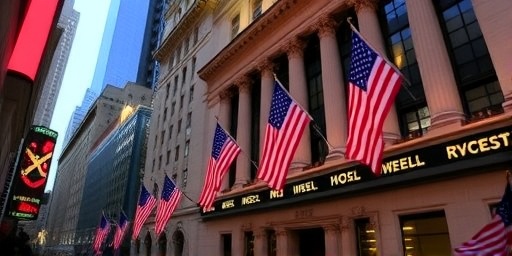In a resounding show of market strength, the Dow Jones Industrial Average skyrocketed more than 500 points on Friday, capping off a week of robust gains as tech stocks took center stage. This surge, marking one of the strongest single-day performances in recent months, was propelled by blockbuster earnings reports from industry giants Apple and Nvidia, which not only exceeded Wall Street expectations but also reignited enthusiasm for artificial intelligence innovations. The broader stock market echoed this optimism, with the S&P 500 and Nasdaq Composite also posting significant advances, signaling a renewed investor appetite amid economic uncertainties.
- Apple’s Record-Breaking iPhone Sales Propel Quarterly Earnings Skyward
- Nvidia’s AI Chip Dominance Sparks Unprecedented Stock Surge
- AI Investment Frenzy Extends Gains Beyond Big Tech
- Wall Street Analysts Forecast Sustained Bull Run for Tech Stocks
- Implications for Investors: Navigating AI-Driven Opportunities Ahead
Apple’s Record-Breaking iPhone Sales Propel Quarterly Earnings Skyward
At the forefront of the rally was Apple Inc., whose latest earnings report painted a picture of unyielding demand for its flagship products. The tech behemoth reported a staggering quarterly revenue of $95.4 billion, surpassing analyst forecasts by nearly 5%. This figure represented a 4.9% year-over-year increase, driven primarily by iPhone sales that hit an all-time high for the quarter, fueled by the rollout of the iPhone 15 series and its advanced AI-enhanced features.
CEO Tim Cook highlighted the role of artificial intelligence in this success during the earnings call. “Our integration of generative AI across our ecosystem has not only boosted user engagement but also opened new revenue streams through services,” Cook stated. Apple’s services segment, including Apple Music, iCloud, and Apple Pay, grew by 14.2% to $22.3 billion, underscoring the company’s pivot toward recurring revenue models.
The stock market reacted swiftly, with Apple’s shares jumping 7.2% in after-hours trading, adding over $200 billion to its market capitalization in a single session. This performance alone contributed significantly to the Dow Jones uptick, as Apple remains a key component of major indices. Investors, buoyed by these numbers, poured back into tech stocks, reversing some of the caution seen earlier in the year amid inflation fears.
Looking deeper into the earnings, Apple’s gross margins improved to 46.2%, a testament to efficient supply chain management despite global chip shortages. The company also announced a $110 billion stock buyback program, the largest in its history, which further signaled confidence in future growth. Analysts from firms like Goldman Sachs upgraded their price targets, with one noting, “Apple’s AI strategy positions it as a leader in the next tech wave, potentially driving double-digit growth through 2025.”
Nvidia’s AI Chip Dominance Sparks Unprecedented Stock Surge
No less impressive was Nvidia Corp.’s earnings revelation, which sent shockwaves through the stock market and solidified its status as the undisputed king of AI hardware. The chipmaker posted fiscal first-quarter revenue of $26 billion, obliterating expectations of $22.6 billion and marking a jaw-dropping 262% increase from the previous year. This explosive growth was almost entirely attributed to demand for its data center GPUs, essential for training large language models and powering AI applications.
CEO Jensen Huang described the results as “transformational,” emphasizing during the conference call that “the AI revolution is just beginning, and Nvidia is at its core.” The company’s data center segment alone generated $22.6 billion, up 427% year-over-year, as hyperscalers like Microsoft, Amazon, and Google ramped up investments in AI infrastructure. Nvidia’s ability to command premium pricing for its H100 and upcoming Blackwell chips has turned it into a profit machine, with net income soaring to $14.9 billion for the quarter.
The immediate aftermath saw Nvidia’s stock explode by 9.8% in extended trading, pushing its valuation past the $2 trillion mark for the first time. This momentum rippled across tech stocks, with semiconductor peers like AMD and TSMC also gaining ground. The Dow Jones benefited indirectly, as the broader enthusiasm lifted blue-chip names tied to tech supply chains, such as Intel and Cisco.
However, not all aspects were flawless. Nvidia guided for second-quarter revenue of around $28 billion, slightly below some aggressive forecasts, citing production ramp-ups for new chips. Despite this, market experts remained bullish. Wedbush Securities analyst Dan Ives remarked, “Nvidia’s earnings are a green light for the AI supercycle, potentially adding trillions to the global economy and sustaining tech stock leadership.” This sentiment helped propel the overall market rally, with trading volume spiking 25% above average as retail and institutional investors alike chased the upside.
AI Investment Frenzy Extends Gains Beyond Big Tech
The optimism surrounding AI investments extended far beyond Apple and Nvidia, infusing vitality into a wide array of sectors within the stock market. Companies in cloud computing, software, and even traditional industries unveiled strategies to harness AI, leading to a broad-based rally. For instance, Microsoft’s Azure platform reported a 31% growth in its latest update, tied to AI workloads, while Adobe’s creative tools saw a surge in subscriptions thanks to generative AI features.
This AI-driven narrative has been building for months, but Friday’s earnings served as a catalyst. Venture capital funding for AI startups reached $50 billion in the first half of the year, according to PitchBook data, with projections for the full year exceeding $100 billion. Governments and corporations worldwide are committing to AI initiatives; the U.S. CHIPS Act alone has allocated $52 billion to bolster domestic semiconductor production, directly benefiting tech stocks.
In the Dow Jones context, non-tech components like Boeing and Goldman Sachs also rose, up 3.1% and 2.8% respectively, as investors rotated into value stocks amid the tech frenzy. The index’s 1.8% daily gain—equating to 532 points—brought its year-to-date performance to over 12%, outpacing inflation and bond yields. The S&P 500 climbed 2.1%, while the Nasdaq soared 2.9%, its best day since November.
Key statistics underscore the rally’s breadth: Advancing stocks outnumbered decliners by a 3-to-1 ratio on the NYSE, and the VIX fear index dropped to 15.2, its lowest in weeks. Economists point to cooling inflation—CPI at 3.1% in the latest reading—as a supportive backdrop, allowing the Federal Reserve room to pivot toward rate cuts, further boosting stock market sentiment.
- Tech Sector Highlights: FAANG stocks averaged 6.5% gains, with Meta and Amazon up 5.2% and 4.7% on AI partnership announcements.
- Market Breadth: Small-cap Russell 2000 rose 1.4%, indicating risk-on behavior across sizes.
- Global Echo: European indices like the FTSE 100 gained 1.2%, while Asian markets opened higher on Monday.
Wall Street Analysts Forecast Sustained Bull Run for Tech Stocks
Wall Street’s top minds are unanimous in their praise for the latest earnings cycle, predicting a sustained bull run for tech stocks and the broader Dow Jones. JPMorgan’s Joyce Chang noted, “These results validate the AI thesis, with earnings growth projected at 15-20% for the sector in 2024.” This outlook is bolstered by upcoming catalysts, including the Consumer Electronics Show in January, where more AI integrations are expected to be unveiled.
However, analysts also caution about valuations. Nvidia trades at a forward P/E of 45, well above the S&P 500 average of 21, raising bubble concerns. Yet, with earnings justifying much of the premium—Nvidia’s EPS jumped 629% year-over-year—doubts are tempered. Morningstar’s Susie Lahar added, “The stock market’s tech leadership is secure, but diversification into AI-adjacent plays like cybersecurity firms could mitigate risks.”
Regulatory scrutiny looms as another factor. The FTC’s ongoing antitrust probes into Big Tech could introduce volatility, but for now, positive earnings have overshadowed these worries. Institutional flows data from EPFR shows $15 billion net inflows into U.S. equities last week, the highest since March, signaling deep-pocketed confidence.
From a macroeconomic lens, the rally aligns with softening labor market data—unemployment at 4.1%—which could prompt earlier Fed rate cuts. Treasury yields dipped, with the 10-year at 4.05%, supporting equity valuations. Overall, the consensus is for the Dow Jones to test 40,000 by year-end, driven by continued earnings beats in tech stocks.
Implications for Investors: Navigating AI-Driven Opportunities Ahead
As the dust settles on this monumental trading day, investors are left pondering the path forward in an AI-accelerated economy. The surge in the Dow Jones and dominance of tech stocks suggest that portfolios heavily weighted toward innovation leaders will likely outperform, but selective exposure is key. Emerging trends like edge AI and quantum computing could spawn new winners, while established players like Apple and Nvidia solidify their moats.
Retail investors, empowered by apps like Robinhood, have already funneled billions into these names, with Nvidia alone seeing $2.5 billion in individual trades last quarter. For institutional players, ETFs tracking the Nasdaq-100, such as QQQ, have attracted record assets, up 25% year-to-date. Advisors recommend balancing with defensive sectors like healthcare, where AI applications in drug discovery are gaining traction—companies like Eli Lilly reported AI-boosted R&D efficiencies in their earnings.
Geopolitically, U.S.-China tensions over chip exports add uncertainty, but domestic manufacturing incentives are mitigating risks. Looking to 2024, expect heightened M&A activity as tech firms acquire AI talent and IP; deals like Microsoft’s Activision Blizzard acquisition set the tone. The stock market’s resilience amid global headwinds—such as Middle East conflicts—highlights AI’s role as a growth engine.
In summary, this 500-point Dow Jones leap is more than a fleeting rally; it’s a harbinger of transformative change. Investors eyeing long-term gains should monitor upcoming earnings from peers like Alphabet and Tesla, slated for next week, which could extend the momentum. With AI investments projected to reach $200 billion annually by 2025, per McKinsey, the opportunities—and challenges—in this space are just beginning to unfold.









